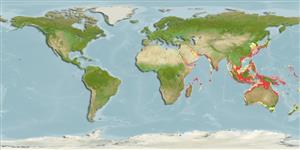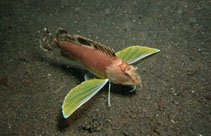Add your observation in Fish Watcher
| Native range | All suitable habitat | Point map | Year 2050 |

|
| This map was computer-generated and has not yet been reviewed. |
| Apistus carinatus AquaMaps Data sources: GBIF OBIS |
Upload your photos and videos
Pictures | Google imageApistus carinatus
Picture by Zuberbuhler, T.
Pictures | Google imageApistus carinatus
Picture by Zuberbuhler, T.
Classification / Names Common names | Synonyms | Catalog of Fishes(genus, species) | ITIS | CoL | WoRMS | Cloffa
Teleostei (teleosts) > Perciformes/Scorpaenoidei (Scorpionfishes) > Apistidae (Wasp scorpionfishes)
Etymology: Apistus: Greek, apisto = uncertain (Ref. 45335).
More on authors: Bloch & Schneider.
Etymology: Apistus: Greek, apisto = uncertain (Ref. 45335).
More on authors: Bloch & Schneider.
Issue
Genus Hypodytes, according to Paxton et al. 1989 (Ref. 7300).
Environment: milieu / climate zone / depth range / distribution range Ecology
Distribution Countries | FAO areas | Ecosystems | Occurrences | Point map | Introductions | Faunafri
Indo-West Pacific: Red Sea and the Persian Gulf south to Natal, South Africa and east to India and the Philippines, north to China and Japan, south Australia.
Size / Weight / Age
Maturity: Lm ? range ? - ? cm
Max length : 20.0 cm TL male/unsexed; (Ref. 48635); common length : 10.0 cm TL male/unsexed; (Ref. 3503)
Max length : 20.0 cm TL male/unsexed; (Ref. 48635); common length : 10.0 cm TL male/unsexed; (Ref. 3503)
Short description Identification keys | Morphology | Morphometrics
Dorsal spines (total): 14 - 16; Dorsal soft rays (total): 8 - 10; Anal spines: 3 - 4; Anal soft rays: 6 - 8. Bluish grey in color, belly pale; large black spot on rear half of spinous dorsal (Ref. 4313).
Inhabits soft bottoms of the continental shelf. Primarily known from trawls over prawn-grounds but divers looking in suitable habitats can come across them, especially at night. During the day it buries itself deep in the sand with just the eyes exposed. When disturbed, it spreads its long pectoral fins with the bright upper color to deter predators. It uses its fins to corner prey and has sensitive barbels below the mouth to detect those buried in the substrate (Ref. 48635). Fin spines venomous (anterolateral glandular groove with venom gland (Ref. 57406)) (Ref. 30573). Sold in small quantities either fresh or dried and salted in markets. Minimum depth reported taken from Ref. 57178.
Life cycle and mating behavior Maturity | Reproduction | Spawning | Eggs | Fecundity | Larvae
Main reference
Upload your references | References | Coordinator | Collaborators
Poss, S.G. and K.V. Rama Rao, 1984. Scorpaenidae. In W. Fischer and G. Bianchi (eds.) FAO species identification sheets for fishery purposes. Western Indian Ocean (Fishing Area 51). Vol. 4. FAO, Rome. pag. var. (Ref. 3503)
CITES
Not Evaluated
Threat to humans
Venomous (Ref. 4716)
Human uses
Fisheries: minor commercial
FAO - Publication: search | FishSource |
More information
Trophic ecology
Food items
Diet composition
Food consumption
Food rations
Predators
Food items
Diet composition
Food consumption
Food rations
Predators
Population dynamics
Growth parameters
Max. ages / sizes
Length-weight rel.
Length-length rel.
Length-frequencies
Mass conversion
Recruitment
Abundance
Growth parameters
Max. ages / sizes
Length-weight rel.
Length-length rel.
Length-frequencies
Mass conversion
Recruitment
Abundance
Life cycle
Reproduction
Maturity
Maturity/Gills rel.
Fecundity
Spawning
Spawning aggregations
Eggs
Egg development
Larvae
Larval dynamics
Reproduction
Maturity
Maturity/Gills rel.
Fecundity
Spawning
Spawning aggregations
Eggs
Egg development
Larvae
Larval dynamics
Anatomy
Gill area
Brain
Otolith
Gill area
Brain
Otolith
Physiology
Body composition
Nutrients
Oxygen consumption
Swimming type
Swimming speed
Visual pigments
Fish sound
Diseases & Parasites
Toxicity (LC50s)
Body composition
Nutrients
Oxygen consumption
Swimming type
Swimming speed
Visual pigments
Fish sound
Diseases & Parasites
Toxicity (LC50s)
Genetics
Genetics
Heterozygosity
Heritability
Genetics
Heterozygosity
Heritability
Human related
Aquaculture systems
Aquaculture profiles
Strains
Ciguatera cases
Stamps, coins, misc.
Aquaculture systems
Aquaculture profiles
Strains
Ciguatera cases
Stamps, coins, misc.
Tools
E-book | Field guide | Identification keys | Length-frequency wizard | Life-history tool | Point map | Classification Tree
| Catch-MSY |
Special reports
Download XML
Internet sources
AFORO (otoliths) | Aquatic Commons | BHL | Cloffa | BOLDSystems | Websites from users | Check FishWatcher | CISTI | Catalog of Fishes: genus, species | DiscoverLife | ECOTOX | FAO - Publication: search | Faunafri | Fishipedia | Fishtrace | GenBank: genome, nucleotide | GloBI | Google Books | Google Scholar | Google | IGFA World Record | MitoFish | National databases | Otolith Atlas of Taiwan Fishes | PubMed | Reef Life Survey | Socotra Atlas | Tree of Life | Wikipedia: Go, Search | World Records Freshwater Fishing | Zoological Record
Estimates based on models
Preferred temperature (Ref. 123201): 23.3 - 29, mean 28 °C (based on 1680 cells).
Phylogenetic diversity index (Ref. 82804): PD50 = 1.1250 [Uniqueness, from 0.5 = low to 2.0 = high].
Bayesian length-weight: a=0.01175 (0.00443 - 0.03114), b=3.02 (2.80 - 3.24), in cm total length, based on LWR estimates for this (Sub)family-body shape (Ref. 93245).
Trophic level (Ref. 69278): 3.6 ±0.4 se; based on size and trophs of closest relatives
Fishing Vulnerability (Ref. 59153): Low vulnerability (10 of 100).




